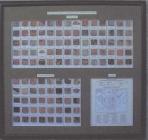1
FLUORSPARIn St. Lawrence, Fluorspar was mined mainly for use in the smelting of aluminum, the production of Freon, the manufacture of glass and for the manufacturing of aviation fuel for the American military. It has been rumored that a government geologist, C.K Howse claimed in his memoirs that he heard an American Military Official State that fluorspar from St. Lawrence was used in the production of the atomic bomb.
Other users are listed below:
In the Chemistry Industry:
Glass etching and polishing
Acid etching
Catalyzer in the production of high octane fuel
Production of primary fluorine
Non-Ferrous Flux for the metallurgical industry
Cleansing & disinfectant agent in the fermentation industry
Polishing distillation flasks in the production of incandescent lamps
Polishing aluminum
Fluoridation agent in organic chemistry
Varnish used in paint-shops & printers
White enameling
High purity aluminum metallurgy
Production of sulphur fluxes
Optional lenses
Electronic Technology
Pyro technology
Catalytic Functions
Nuclear Technology
Metal Processing
Petroleum Forges
Electro-deposition
Disinfectants for breweries & distilleries
Wood preserving agent
Compounds for welding fluxes
Insecticides
Fluoridation of drinking water
Addictive for dentifrices
Insulation & refrigerant gas in electro-technology
Propellant gas for aerosols
Propellant gas for cellular products such as plasticizes polyurethane foams, and phenolic foams, and polystyrene foams.
Refrigerant & Air Conditioning
Solvents
As a second generation substitute for blood
Bonding of diamond to metal to form special abrasive wheels
Fluor elastomers used in automotive fuel systems
Solar heating systems
Local anesthetics
Special paints for resistance to corrosion, UV light, & Atmosphere
In the steel industry:
Steel Production
Metallurgical grade fluorspar is added as a fluxing agent to the melt to improve slag fluidity and to assist the passage of contaminants away from the molten metal. Acid grade fluorspar is often blended with other addictive's such as lime and compressed with a binder to form a briquette. These small blocks are then added directly to the furnace.
Welding Electrodes
Fluorspar aids in the fluidity of slag during welding and is therefore one of the additives to some welding rod coatings.
In Glass and Enamels
Fluorspar is used as a fluxing agent and added to the melt where it assists in melting and increasing fluidity of the charge. It is used in the glass bottle making industry as both a fluxing and refining agent where it removes bubbles from the molten glass.
PROPERTIES OF FLUORSPAR
Cleavage -The propensity of crystalline minerals to split in one or more directions either along or parallel to certain places when struck by a blow.
-Fluorspar has o (111) Perfect cleavage.
Fracture -A crack or break in a rock or mineral.
-Fluorspar has a flat0conchoidal, brittle fracture.
Hardness -The resistance of a mineral to scratching.
-Fluorspar has a hardness of 4 on a scale of 1 to 10.
Luster -The reflection of light from the surface of mineral
-Fluorspar has a virtuous luster.
Specific Gravity - The ratio of the density of a material to the density of water.
-Fluorspar has a specific gravity of 3.01 to 3.25 or 3.18 crystallized.
Color -Fluorspar can range from colorless to white, yellow, red, green, blue, violet, and black.
Transparent -Fluorspar is sub translucent and sometimes shows a bluish fluorescence.
-Fluorspar is made up of 48.9% fluorine, and 51.1% calcium

